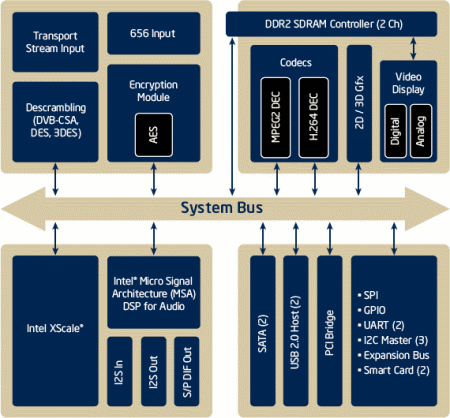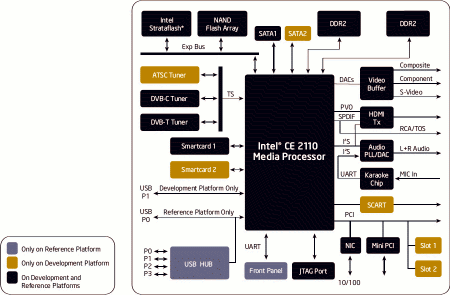Intel unveils new XScale set-top box chip
Apr 17, 2007 — by LinuxDevices Staff — from the LinuxDevices Archive — 4 viewsAt its developer forum in Beijing today, Intel unveiled its first SoC (system-on-chip) specifically targeting digital set-top boxes (STBs) and media recorders. The Intel CE 2110 is based on a 1GHz XScale core, and is shipping to early customers now, along with Linux-based development and reference design kits.
The CE 2110 is designed for use in highly integrated consumer electronic devices, including STBs and DVRs (digital video recorders). The chip has the performance and peripheral mix needed to support “advanced revenue-generating services,” Intel said, citing VoIP (voice-over-IP), videophone, interactive gaming, “enhanced karaoke,” and e-learning applications.

Intel CE 2110 diagram
(Click to enlarge)
The CE 2110 combines a 1GHz XScale core with:
- DDR2 memory interface supporting 64MB to 512MB
- High-definition MPEG-2 and H.264 decoder hardware
- Programmable “micro signal architecture” (MSA) DSP (digital signal processor), for future-proof audio codec support
- 2D/3D IGP (integrated graphics processor)
- 8-/16-bit expansion interface for flash memory
- 2 x 32-bit 500 MT/s DDR2 SDRAM interfaces (configurations from 64 MB to 512 MB)
- Hardware accelerators for encryption/decryption — DVB-CSA, DES, 3DES, AES
- A/V in:
- Transport stream interface for ATSC/DVB tuner inputs
- BT.656 input (NTSC/PAL analog video in) + I2S (analog audio in)
- A/V out:
- Analog component, or S-Video & composite (supports closed captioning, Macrovision 7.1 & CGMS-A copy protection)
- Interface for external HDMI transmitter with HDCP
- 2-channel, 6-channel I2S out
- S/PDIF out
- 33MHz 32-bit PCI 2.2 host with support for 4 external masters
- 2 x serial ATA interfaces for HDD or DVD drives
- USB 2.0 host
- 11 dedicated GPIO (plus 82 MUXed GPIO)
- 2 x integrated UARTs
- Watchdog and system timers
- 3 x I2C interfaces for system control
- 1 x SPI high-speed serial bus
- 2 x integrated ISO7816 interfaces for smart cards
Development and reference design kits
Intel is offering Linux-based development and reference design kits for the CE 2110 processor. The former targets application development, and includes a motherboard, tuner cards, power supply, documentation, a software support package, and Linux operating system support. The latter is described as a “hybrid” design that includes a motherboard, front panel, power supply, chassis, remote control, documentation, software support package, and “support for the Linux operating system.”

Intel CE 2110 dev and ref design kits
(Click to enlarge)
Intel said its CE 2110 chip has already been selected by Taiwanese telecom service provider Chunghwa for a “multimedia-on-demand” service offering high-definition video content, karaoke, e-banking, and e-learning services. Other early design wins reportedly include digital STBs from ASUS, OKI, and ZTE, and a multi-room HD DVR from Moxi. Other early customers include Hwacom, Radvision, Amino, and Verimatrix, Intel said.
William O. Leszinske, Jr., GM of Intel's CE group, stated, “The Internet is a powerful disruptive opportunity for the CE industry. Intel's work with the CE ecosystem to power new intelligent devices will help accelerate the availability of a new range of exciting Internet-based information and services, and video entertainment experiences for consumers throughout the home.”
Cy Feng, Asus VP of broadband, stated, “Intel's platform solution is designed to be a multifunction device, and in this respect, it stands apart from traditional set top boxes.”
Manufactured on Intel's 90nm process, the CE 2110 has a 35mm lead-free FC-BGA package. Pricing was not disclosed.
This article was originally published on LinuxDevices.com and has been donated to the open source community by QuinStreet Inc. Please visit LinuxToday.com for up-to-date news and articles about Linux and open source.